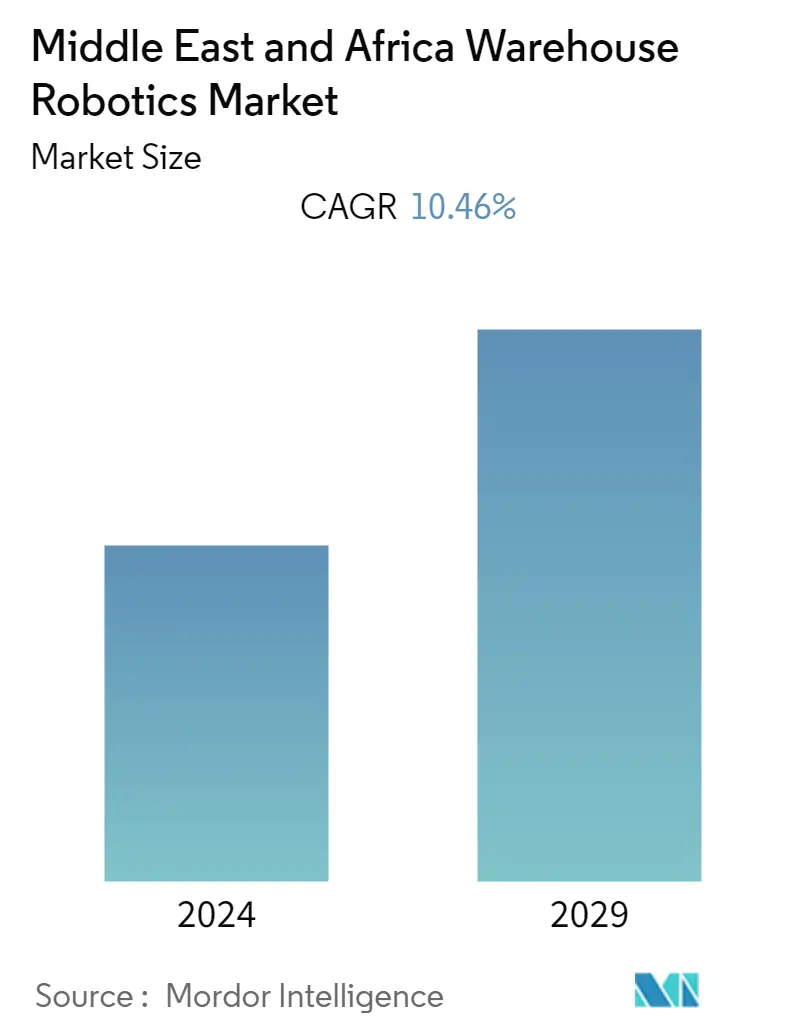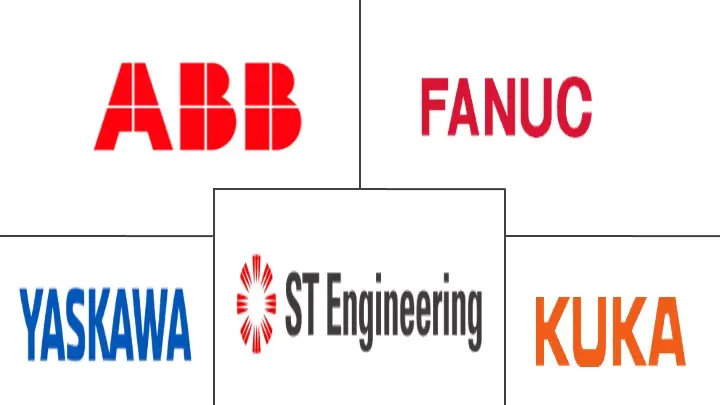Market Size of Middle East and Africa Warehouse Robotics Industry

| Study Period | 2019 - 2029 |
| Base Year For Estimation | 2023 |
| Forecast Data Period | 2024 - 2029 |
| Historical Data Period | 2019 - 2022 |
| CAGR | 10.46 % |
| Market Concentration | Medium |
Major Players
*Disclaimer: Major Players sorted in no particular order |
MEA Warehouse Robotics Market Analysis
The Middle East and Africa warehouse robotics market is expected to register a CAGR of 10.46% during the forecast period 2020 - 2025. The Middle Eastern region is highly dependent on food and beverage imports each year, due to low agricultural capacity. In July 2019, the Saudi Arabian government announced its third tender for 2019, to import 715,000 metric ton of wheat for supply during the period September-November 2019, distributed over 12 vessels. Thus, there is a rise in the demand for storage areas, which can be fulfilled by various warehouses which are using robotic systems.
- South Africa is one of the largest economies in the African continent. Intra-Africa trade is on the rise. African countries signed a trade agreement in March 2018 called the African Continental Free Trade Area Agreement (AfCFTA), which permitted countries to remove tariffs on 90% of goods, progressively liberalize trade in services, and address a host of other non-tariff barriers. These kind of agreements are expected to increase the need for robotics to ease the management of goods.
- South Africa, being a major tourist attraction in Africa, is investing heavily in airports, and is the single largest and fastest growing segment in the MEA. Three South African Airports, Cape Town, Durban, and Johannesburg's international airports, were considered to be the best in the world, as well as were awarded the 2019 Skytrax World Airport Awards.
- In 2019, Quicktron announced the launch of the first intelligent robot logistics center in the Middle East in Dubai, marking the success of Quicktron's global intelligent robot solutions across the Middle East and North Africa.
- The IQ Fullfilment project with Quicktron is located in Dubai investment park, and its business is through the use of advanced intelligent robot and advanced software platform for enterprise users with efficient and revolutionary innovation of supply chain logistics solutions, which help enterprises seamlessly integrate into the operation, reduce the financial burden on business performance, and to provide products and services of supply chain based on intelligent robot, including intelligent storage, intelligent sorting and selection, product quality inspection and measurement, brand service, etc.
- Moreover, with the spread of the Covid-19 pandemic, robots and automation are already playing a critical role in managing the situation. Further, the situation is likely to bring new opportunities to the market.
MEA Warehouse Robotics Industry Segmentation
Warehouse is the most vital part in the supply chain process. They perform products transit that starts from process of production facility, acknowledgement, organizing, and also the tagging for delivering product on the required address. Warehouse robotics is the adoption of robotics in the warehouse that performs functions like Storage, Packaging, Trans-shipment, and Other Functions. End Users considered under the scope includes Food and Beverage, Automotive, Retail, Electrical and Electronics, Pharmaceutical,and Other End Users. The scope of the market is comprehensive and is limited to Middle East and Africa.
| Type | |
| Industrial Robots | |
| Sortation Systems | |
| Conveyors | |
| Palletizers | |
| Automated Storage and Retrieval System (ASRS) | |
| Mobile Robots (AGVs and AMRs) |
| Function | |
| Storage | |
| Packaging | |
| Trans shipments | |
| Other Functions |
| End User | |
| Food and Beverage | |
| Automotive | |
| Retail | |
| Electrical and Electronics | |
| Pharmaceutical | |
| Other End Users |
| Country | |
| Saudi Arabia | |
| South Africa | |
| United Arab Emirates | |
| Rest of Middle East and Africa |
Middle East and Africa Warehouse Robotics Market Size Summary
The Middle East and Africa warehouse robotics market is experiencing significant growth, driven by increasing demand for efficient storage and logistics solutions. The region's reliance on food and beverage imports, coupled with rising intra-Africa trade, has heightened the need for advanced robotic systems in warehouses. South Africa's economic activities, including tourism and trade agreements like the African Continental Free Trade Area Agreement, are further propelling the adoption of robotics to streamline goods management. The introduction of intelligent robot logistics centers, such as Quicktron's initiative in Dubai, highlights the region's commitment to integrating advanced technologies into supply chain operations. The Covid-19 pandemic has also accelerated the adoption of automation, presenting new opportunities for market expansion.
The market is characterized by a moderate level of fragmentation, with major players expanding their presence and forming strategic partnerships to enhance their market share. The demand for sortation and packaging systems is driven by sectors such as e-commerce, food and beverages, and postal services, which require faster and more accurate delivery solutions. Despite challenges like high initial investments and space requirements, tailored solutions are being offered to meet the evolving needs of these industries. In Saudi Arabia, the development of the automotive industry and the expansion of key airports are expected to further boost the demand for warehouse robotics. Recent advancements by companies like ABB and Yaskawa Motoman underscore the ongoing innovation in the sector, aiming to optimize space and improve operational efficiency.
Middle East and Africa Warehouse Robotics Market Size - Table of Contents
-
1. MARKET DYNAMICS
-
1.1 Market Overview
-
1.2 Industry Attractiveness - Porter's Five Forces Analysis
-
1.2.1 Bargaining Power of Suppliers
-
1.2.2 Bargaining Power of Buyers/Consumers
-
1.2.3 Threat of New Entrants
-
1.2.4 Threat of Substitute Products
-
1.2.5 Intensity of Competitive Rivalry
-
-
1.3 Market Drivers
-
1.3.1 Increasing Investments in Technology and Robotics
-
-
1.4 Market Challenges
-
1.4.1 Hight Initial Cost is a Major Challenge
-
-
1.5 Assessment of Impact of COVID-19 on the market
-
-
2. MARKET SEGMENTATION
-
2.1 Type
-
2.1.1 Industrial Robots
-
2.1.2 Sortation Systems
-
2.1.3 Conveyors
-
2.1.4 Palletizers
-
2.1.5 Automated Storage and Retrieval System (ASRS)
-
2.1.6 Mobile Robots (AGVs and AMRs)
-
-
2.2 Function
-
2.2.1 Storage
-
2.2.2 Packaging
-
2.2.3 Trans shipments
-
2.2.4 Other Functions
-
-
2.3 End User
-
2.3.1 Food and Beverage
-
2.3.2 Automotive
-
2.3.3 Retail
-
2.3.4 Electrical and Electronics
-
2.3.5 Pharmaceutical
-
2.3.6 Other End Users
-
-
2.4 Country
-
2.4.1 Saudi Arabia
-
2.4.2 South Africa
-
2.4.3 United Arab Emirates
-
2.4.4 Rest of Middle East and Africa
-
-
Middle East and Africa Warehouse Robotics Market Size FAQs
What is the current Middle East and Africa Warehouse Robotics Market size?
The Middle East and Africa Warehouse Robotics Market is projected to register a CAGR of 10.46% during the forecast period (2024-2029)
Who are the key players in Middle East and Africa Warehouse Robotics Market?
ABB Limited , KUKA Aktiengesellschaft (KUKA), Yaskawa Motoman, Singapore technologies Engineering Ltd. and Fanuc Corporation are the major companies operating in the Middle East and Africa Warehouse Robotics Market.

